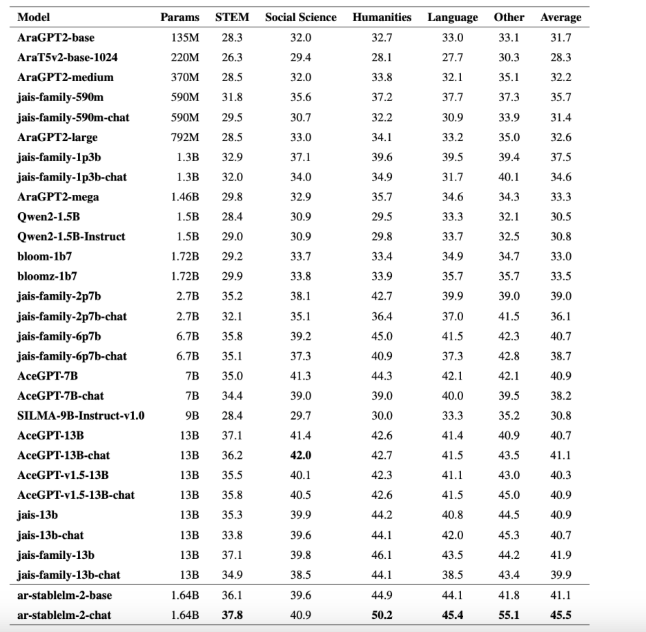Arabic has always faced challenges in the field of natural language processing. Large-scale language models (LLMs) are mostly targeted at English. As a result, Arabic models are either large in scale and consume huge resources, or it is difficult to reflect cultural details. This limits the application and development of Arabic NLP. In order to solve this problem, Stability AI launched the Arabic Stable LM1.6B model, which is a breakthrough attempt to balance efficiency and performance.
With the widespread application of large language models (LLMs) in the field of natural language processing (NLP), the performance of tasks such as text generation and language understanding has been significantly improved. However, Arabic is still underestimated in the application of language models due to its complex inflections, rich dialects and cultural backgrounds.
Many advanced language models focus on English, resulting in Arabic-related models that are either too large and computationally demanding, or fail to fully reflect cultural details. Models with more than 7 billion parameters, such as Jais and AceGPT, have powerful capabilities, but due to huge resource consumption, it is difficult to be promoted in widespread applications. Therefore, there is an urgent need for an Arabic model that balances efficiency and performance.
To solve this problem, Stability AI launched the Arabic Stable LM1.6B model, including basic version and chat version. This model, as an Arabic-centric LLM, achieves excellent results on cultural alignment and language understanding benchmarks for its scale. Unlike large models with over 7 billion parameters, Arabic Stable LM1.6B reduces computational requirements while maintaining good performance.
The model is fine-tuned on over 100 billion Arabic text tokens, ensuring strong representation of Modern Standard Arabic and various dialects. In particular, the chat version model performed well in cultural benchmarks, demonstrating strong accuracy and contextual understanding.
This new model from Stability AI blends real-world instruction data sets with synthetic dialogue generation, allowing it to effectively handle culturally nuanced queries while maintaining broad applicability across a variety of NLP tasks.
In terms of technology, Arabic Stable LM1.6B adopts an advanced pre-training architecture targeted at the characteristics of the Arabic language. Key design elements include:
Tag optimization: The model uses the Arcade100k tagger to balance tag granularity and vocabulary size to reduce the over-tagged problem in Arabic text.
Diverse dataset coverage: Training data comes from a wide range of sources, including news articles, web content, and e-books, ensuring comprehensive representation of literary and spoken Arabic.
Instruction Tuning: The dataset contains synthetic instruction-response pairs, including retelling conversations and multiple-choice questions, improving the model's ability to handle culture-specific tasks.
The Arabic Stable LM1.6B model marks important progress in the field of Arabic NLP, achieving strong results on benchmarks such as ArabicMMLU and CIDAR-MCQ. For example, Chat Edition scored 45.5% on the ArabicMMLU benchmark, surpassing other models with parameters ranging from 700 million to 13 billion. In the CIDAR-MCQ benchmark test, the chat model also performed quite strongly, scoring 46%.

By combining real and synthetic datasets, the model achieves scalability while maintaining practicality for a variety of NLP applications. The launch of Arabic Stable LM1.6B not only solves the computational efficiency and cultural alignment issues in Arabic NLP, but also provides a reliable tool for Arabic natural language processing tasks.
Chat model: https://huggingface.co/stabilityai/ar-stablelm-2-chat
Basic model: https://huggingface.co/stabilityai/ar-stablelm-2-base
Paper: https://arxiv.org/abs/2412.04277
Highlights:
? The Arabic Stable LM1.6B model is designed to solve the problems of computational efficiency and cultural alignment in Arabic NLP.
? The model performs well on multiple benchmarks, outperforming many models with larger parameters.
? Stability AI achieves the practicality and scalability of the Arabic model by fusing real-life data to synthesize data.
All in all, Stability AI's Arabic Stable LM1.6B model has brought significant progress to the field of Arabic natural language processing. Its efficiency and cultural adaptability make it a tool with great potential and is expected to promote the further advancement of Arabic NLP. develop. Model links and paper links have been provided to facilitate readers to learn more.